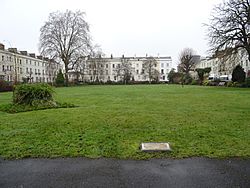Brunswick Square, Gloucester facts for kids
Quick facts for kids Brunswick Square |
|
|---|---|
| Garden square | |
 Brunswick Square's public garden |
|
| Design: | Thomas Reece |
| Opening date: | 1825 |
| Area: | 1.5 acres |
| Surface: | Grass |
| Owner: | Brunswick Square Central Lawn Association |
| Location: | Gloucester, England |
Brunswick Square is a special garden that's owned by a private group but open to the public. It covers about 1.5 acres in the city of Gloucester, England. Rows of houses and apartments surround the square on three sides. You can also see Christ Church to the east. The Gloucester National Spiritualist Church is on the north side. Gloucester House is on the south side. Nine buildings around the square are listed as historic. This means they are important and protected. Brunswick Square has been part of a special conservation area since 1968.
Contents
History of Brunswick Square
Brunswick Square has a very long history. It goes all the way back to the Roman times. Back then, it was known as the Gaudy Green. This name came from a Latin word meaning "to enjoy."
Roman Times and Early Uses
When people dug up parts of the area, they found a Roman graveyard. This graveyard was to the north of the square. It probably stretched into the square itself. A street nearby, Albion Street, is also thought to be from Roman times.
Later, during the Elizabethan era, the city's stocks were on the green. Stocks were a wooden frame used to hold people as punishment. The green was also a place for fun. People would practice archery there.
The English Civil War at Brunswick Square
In 1643, a big event happened here during the English Civil War. King Charles I's soldiers set up a camp on the green. Prince Rupert led these royalist troops. They were trying to take over Gloucester, which supported Parliament.
From the green, the royalists dug tunnels under the city walls. They also placed three large cannons on the green. They fired these cannons at the city's south gate.
How Brunswick Square Became a Garden
In the mid-1700s, this area was called Littleworth. It was the poorest part of the city. The houses were in bad condition and had no proper sanitation.
Things changed when the Gloucester and Sharpness Canal opened in 1827. This brought more money to Gloucester. The green was sold by its owner, the Duke of Norfolk. Between 1822 and 1825, a man named Thomas Reece developed the area. By 1825, 19 terraced houses were built. The middle part was kept as a garden.
On April 15, 1825, all the residents signed a special agreement. This agreement said that nothing could ever be built on the garden. The area became known as Brunswick Square. It was named after Caroline of Brunswick, who was the wife of King George IV. A group called the Brunswick Square Central Lawn Association was formed. They manage and take care of the garden.
Brunswick Square in Modern Times
During World War II, the square became a bit run-down. In 1942, the metal railings around the garden were taken away. The metal was used to help with the war effort.
In the 1960s, the city council wanted to turn the square into a car park. But the agreement signed in 1825 stopped this from happening. In 2000, the gardens were restored. This was possible thanks to a £25,000 grant. The money came from the Gloucestershire Environmental Trust and Cory Environmental.
Royal Visits to Brunswick Square
Brunswick Square has had some important visitors over the years.
King Edward VII's Visit
On June 3, 1909, King Edward VII visited the square. It is believed that about 10,000 schoolchildren were there to meet him.
Princess Mary's Visit
In the 1930s, Princess Mary also visited the area. She went to the YMCA building at 18 Brunswick Square.
Historic Buildings at Brunswick Square
Many buildings around Brunswick Square are listed as important historic sites. This means they are protected because of their special history or architecture. Here are some of them:
- 2 Brunswick Square
- 4–5 Brunswick Square
- 8–9 Brunswick Square
- 10 Brunswick Square
- 11 Brunswick Square
- 12–18 Brunswick Square
- 20–25 Brunswick Square
- 26–27 Brunswick Square
- 28 Brunswick Square

